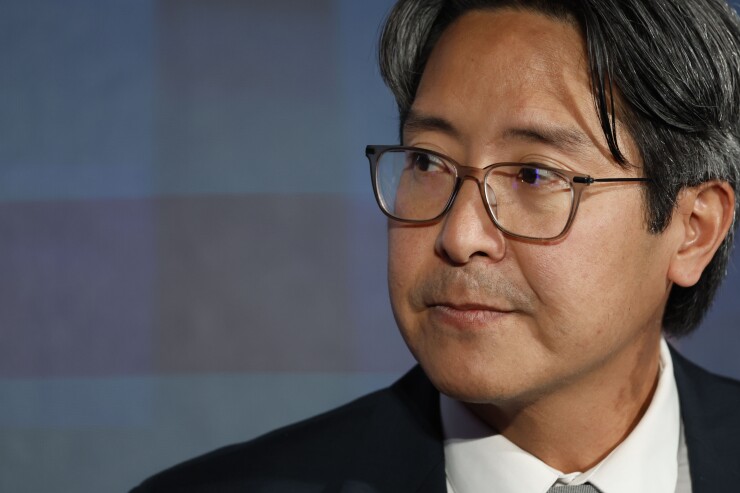
WASHINGTON — Acting Comptroller of the Currency Michael Hsu Wednesday said his agency is reviewing its preemption regulations in light of a recent Supreme Court decision —
"Fortifying core preemption powers will provide certainty where it matters the most — i.e., with regard to safety and soundness and compliance with federal laws and regulations … is legally absolute and non-negotiable, and the OCC will act accordingly to defend that," he said. "At the same time, we are reviewing the agency's 2020 interpretation of preemption under the Dodd-Frank Act to determine whether updates are needed in light of the recent Cantero decision."
The Supreme Court's decision in Cantero held that the Second Circuit had applied the wrong test when it ruled the National Bank Act preempted a New York law requiring banks to pay interest on escrow accounts as applied to national banks. The lower court had found that the NBA preempted New York's escrow interest law because it was deemed to exert "control" over the national bank's power to create and fund escrow accounts by requiring the national bank to pay interest on customer's escrow accounts. The Supreme Court
Named after a precedent established in a 1996 case known as Barnett Bank of Marion County, N.A. v. Nelson — the last time the Supreme Court reviewed national bank preemption under the National Bank Act — the Barnett precedent requires courts to consider whether state law prevents or "significantly interferes" with a national bank's exercise of its powers. In addition to the "significantly interferes" test, the Supreme Court directed the Second Circuit to re-evaluate the case using the text of the state law, relevant precedents and using "common sense."
Hsu indicated that in light of the decision, the agency will work to define what kinds of functions the agency believes are ironclad functions of national banks — which may preempt certain state laws which interfere with such functions — as well as update its regulations around nonessential functions that satisfy the Barnett test and that national banks must observe.
Hsu said the OCC will continue to vigorously defend preemption as a key structural basis for the dual banking system, while acknowledging the need to ensure preemption does not inflict consumer harm.
"Updating that interpretation could be a helpful step toward that," he said. "The combination of vigorously defending core preemption, while being more precise in defining and applying the Barnett standard, will sharpen the OCC's preemption powers."
Hsu also touched on the increasing complexity of bank-nonbank relationships, noting —
"These fintechs, in turn, partner with banks — sometimes indirectly through intermediaries or other 'middleware' firms — to execute on the services offered," he said. "Banks, in turn, rely on a host of nonbank service providers such as core processors to support a range of operations and functions … like corporations and governments, [these partnerships] are increasingly reliant on a handful of large cloud service providers to support their digitalization initiatives."
Drawing on
"This makes it challenging to know who is responsible for what — a challenge that is playing out tragically for the millions of consumers and end users caught up in the Synapse bankruptcy," he noted. "The risks from deposit arrangements and necessary controls may differ from those needed for payments arrangements, and further differences exist for lending arrangements between banks and nonbanks [and] exploring each of those in more detail is a priority."
Federal banking agencies like the OCC have so far relied on the Bank Services Company Act for the authority to examine third-party service providers and on third-party risk management guidance to inform banks' engagements with nonbanks. However, Hsu emphasized that the continued evolution and proliferation of bank-nonbank arrangements necessitate more granular approaches and greater direct engagement between the regulators and nonbank fintechs.
Hsu also said there is a regulatory gap between fintechs — which generally hold state-issued money transmitter licenses — and their banking partners. He argued that the regime has led to customer confusion, with fintechs sometimes misleadingly marketing their services as FDIC-insured.
"Addressing this and other infirmities of the money transmitter regulatory regime through state-by-state action is highly unlikely," he said. "Rather, tailored federal payments regulation and supervision is needed."
Hsu went on to highlight the significant growth in bank sizes over the past three decades. Thirty years ago — according to FDIC research — only five banks held assets of at least $100 billion, collectively amounting to $800 billion. By 2008, this number had surged to 18 large banks, with combined assets reaching $8.8 trillion. Today, 32 large banks hold aggregate assets exceeding $17 trillion. In contrast, community and midsize banks have experienced relatively stable growth compared to their larger counterparts.
Such growth calls for heightened agency scrutiny over large bank regulatory reforms, since many of the last revisions to Dodd-Frank regulations were completed at a time when large banks held only $10 trillion in assets, compared with the $17 trillion they hold today.
Additionally, Hsu addressed the importance of ensuring banks are no longer "too big to fail" or "too big to manage," stressing the need for large banks to have sufficient long-term debt to absorb outsize losses and strong resolution capabilities.
"The public needs credible assurance that large banks can manage their risks and comply with laws and regulations," Hsu said. "If large banks can't do so, regulators need to take appropriate action in a timely manner, including taking enforcement actions, imposing civil money penalties, restricting business activities, limiting capital actions, or even compelling divestitures, as necessary."






